Quantifying the Acoustic Bias of Insect Noise on Wind Turbine Sound Power Levels at Low Wind Speeds †
Abstract
1. Introduction
- Background and WTN measurements should be conducted at the same location and under similar meteorological conditions (time of day, wind speed/direction).
- The measurement procedure itself significantly influences results, as wind speed, wind direction, sound propagation conditions, the presence of other noise sources, and distances to obstacles all affect recorded noise levels [20].
- The presence of vegetation, which varies seasonally, can influence outcomes. Measurements taken in winter, for instance, may yield different results than those taken in summer.
- Scheduled measurements during periods of minimal animal activity (e.g., cooler months or morning hours) [31].
Objective of the Study
2. Methodology
2.1. Measurements and Equipement
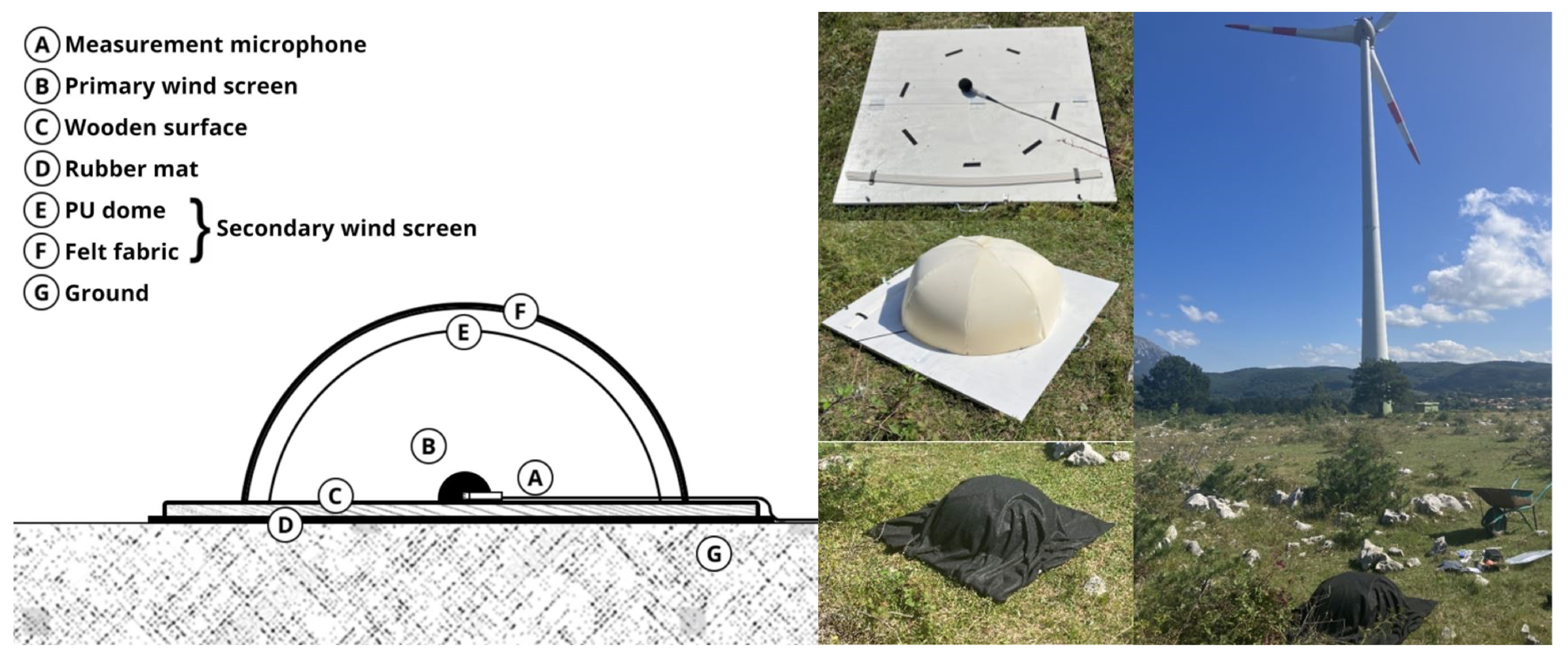
2.2. Acoustic Data Processing and Insect Classification
- Insect reference: merged, species-specific call files from extracted segments,
- Field recordings: continuous WTN recordings subject to classification.
3. Results
4. Discussion
5. Conclusions
Limitations and Future Work
Author Contributions
Funding
Institutional Review Board Statement
Informed Consent Statement
Data Availability Statement
Conflicts of Interest
Abbreviations
| WT | Wind Turbine |
| WTN | Wind Turbine Noise |
| GMM | Gaussian Mixture Model |
| SPL | Sound Pressure Level (based on pressure and Pa) [dBA] |
| WTSPL | Wind Turbine Sound Power Level (based on power and W) [dBA] |
References
- Andrej, H.; Jure, M.; Jurij, P. Influence of Biological Sounds on Long-Term Measurements of Wind Turbine Noise. In Proceedings of the 11th International Conference on Electrical, Electronics and Computer Engineering (IcETRAN), Novi Sad, Serbia, 3–6 June 2024; Available online: https://www.etran.rs/2024/E_ZBORNIK_IcETRAN_2024/001_AKI1.3.pdf (accessed on 22 September 2025).
- Caporale, D.; Sangiorgio, V.; De Lucia, C. Extended reality-based choice experiment to assess the impact of offshore wind turbines in historic center: The case of Manfredonia. J. Environ. Manag. 2024, 349, 119454. [Google Scholar] [CrossRef]
- Pepermans, G.; Rousseau, S. Consumers and citizens: Identity salience in choice settings focusing on local wind turbines. J. Environ. Manag. 2021, 281, 111857. [Google Scholar] [CrossRef]
- Trucco, A. Predicting Underwater Noise Spectra Dominated by Wind Turbine Contributions. IEEE J. Ocean. Eng. 2024, 49, 1675–1694. [Google Scholar] [CrossRef]
- Yang, C.; Ding, S.; Zhou, G. Wind turbine blade damage detection based on acoustic signals. Sci. Rep. 2025, 15, 3930. [Google Scholar] [CrossRef]
- Ferreira da Silva, M.; Nunes Masson, J.E.; Santos, M.F.d.; Rodrigues Silva, W.; Wladimir Molina, I.; Martins, G.M.C. Audible Noise Evaluation in Wind Turbines Through Artificial Intelligence Techniques. Sensors 2025, 25, 1492. [Google Scholar] [CrossRef] [PubMed]
- Araújo Alves, J.; Neto Paiva, F.; Torres Silva, L.; Remoaldo, P. Low-Frequency Noise and Its Main Effects on Human Health—A Review of the Literature between 2016 and 2019. Appl. Sci. 2020, 10, 5205. [Google Scholar] [CrossRef]
- Rkhiss, A.; Finez, A.; Gloaguen, J.R.; Maillard, J.; Vasile, G. Automatic estimation of the wind turbine noise with recurrent neural networks. In INTER-NOISE and NOISE-CON Congress and Conference Proceedings, Proceedings of the 53rd International Congress and Exposition on Noise Control Engineering, Nantes, France, 25–29 August 2024; Institute of Noise Control Engineering: Wakefield, MA, USA, 2024; Volume 270, pp. 3020–3030. [Google Scholar]
- Ciaburro, G.; Iannace, G.; Puyana-Romero, V.; Trematerra, A. Machine Learning-Based Tools for Wind Turbine Acoustic Monitoring. Appl. Sci. 2021, 11, 6488. [Google Scholar] [CrossRef]
- Wang, Q.; Zhang, H.; Wang, X.; Ni, Y. Wind Turbine Airfoil Noise Prediction Method Based on Generalized Airfoil Database and Residual Neural Network. Appl. Sci. 2025, 15, 5123. [Google Scholar] [CrossRef]
- Yang, H.; Yuan, W.; Zhu, W.; Sun, Z.; Zhang, Y.; Zhou, Y. Wind turbine airfoil noise prediction using dedicated airfoil database and deep learning technology. Appl. Energy 2024, 364, 123165. [Google Scholar] [CrossRef]
- Alamir, M.A.; Hansen, K.L.; Zajamsek, B.; Catcheside, P. Subjective responses to wind farm noise: A review of laboratory listening test methods. Renew. Sustain. Energy Rev. 2019, 114, 109317. [Google Scholar] [CrossRef]
- Gallo, P.; Fredianelli, L.; Palazzuoli, D.; Licitra, G.; Fidecaro, F. A procedure for the assessment of wind turbine noise. Appl. Acoust. 2016, 114, 213–217. [Google Scholar] [CrossRef]
- Fredianelli, L.; Carpita, S.; Licitra, G. A procedure for deriving wind turbine noise limits by taking into account annoyance. Sci. Total Environ. 2019, 648, 728–736. [Google Scholar] [CrossRef] [PubMed]
- Zagubień, A.; Wolniewicz, K. The impact of supporting tower on wind turbine noise emission. Appl. Acoust. 2019, 155, 260–270. [Google Scholar] [CrossRef]
- Fredianelli, L.; Gallo, P.; Licitra, G.; Carpita, S. Analytical assessment of wind turbine noise impact at receiver by means of residual noise determination without the wind farm shutdown. Noise Control Eng. J. 2017, 65, 417–433. [Google Scholar] [CrossRef]
- Echeverri-Londoño, C.A.; González-Fernández, A.E. Model for the prediction of noise from wind turbines. Rev. Fac. De Ing. Univ. De Antioq. 2018, 55–65. [Google Scholar] [CrossRef]
- Iannace, G.; Berardi, U.; Ciaburro, G.; D’Orazio, D.; Trematerra, A. Mini-wind turbine noise measured inside near-by houses. Can. Acoust. 2020, 48, 18–20. [Google Scholar]
- Zagubien, A. Measurement of Background Noise in the Environment-Cases Studies. Rocz. Ochr. Srodowiska 2018, 20, 1498–1514. [Google Scholar]
- Öhlund, O.; Larsson, C. Meteorological effects on wind turbine sound propagation. Appl. Acoust. 2015, 89, 34–41. [Google Scholar] [CrossRef]
- Guest, E.E.; Stamps, B.F.; Durish, N.D.; Hale, A.M.; Hein, C.D.; Morton, B.P.; Weaver, S.P.; Fritts, S.R. An updated review of hypotheses regarding bat attraction to wind turbines. Animals 2022, 12, 343. [Google Scholar] [CrossRef]
- Kunz, T.H.; Arnett, E.B.; Cooper, B.M.; Erickson, W.P.; Larkin, R.P.; Mabee, T.; Morrison, M.L.; Strickland, M.D.; Szewczak, J.M. Assessing impacts of wind-energy development on nocturnally active birds and bats: A guidance document. J. Wildl. Manag. 2007, 71, 2449–2486. [Google Scholar] [CrossRef]
- Jansson, S.; Malmqvist, E.; Brydegaard, M.; Åkesson, S.; Rydell, J. A Scheimpflug lidar used to observe insect swarming at a wind turbine. Ecol. Indic. 2020, 117, 106578. [Google Scholar] [CrossRef]
- Rydell, J.; Bogdanowicz, W.; Boonman, A.; Pettersson, S.; Suchecka, E.; Pomorski, J.J. Bats may eat diurnal flies that rest on wind turbines. Mamm. Biol. 2016, 81, 331–339. [Google Scholar] [CrossRef]
- Reusch, C.; Lozar, M.; Kramer-Schadt, S.; Voigt, C.C. Coastal onshore wind turbines lead to habitat loss for bats in Northern Germany. J. Environ. Manag. 2022, 310, 114715. [Google Scholar] [CrossRef] [PubMed]
- Leroux, C.; Le Viol, I.; Valet, N.; Kerbiriou, C.; Barré, K. Disentangling mechanisms responsible for wind energy effects on European bats. J. Environ. Manag. 2023, 346, 118987. [Google Scholar] [CrossRef]
- Ashtiani, P.; Denison, A. Spectral Discrete Probability Density Function of Measured Wind Turbine Noise in the Far Field. Front. Public Health 2015, 3, 52. [Google Scholar] [CrossRef]
- Cooper, S. Wind Farm Noise—Modulation of the Amplitude. Acoustics 2021, 3, 364–390. [Google Scholar] [CrossRef]
- Smith, M.; Chiles, S. Analysis techniques for wind farm sound level measurements. Acoust. Aust./Aust. Acoust. Soc. 2012, 40, 51–56. [Google Scholar]
- Hessler, G.F.; Hessler, D.M.; Bay, K. Experimental study to determine wind-induced noise and windscreen attenuation effects on microphone response for environmental wind turbine and other applications. Noise Control Eng. J. 2008, 56, 300–309. [Google Scholar] [CrossRef]
- Whalen, C.E.; Brown, M.B.; McGee, J.; Powell, L.A.; Walsh, E.J. Effects of wind turbine noise on the surrounding soundscape in the context of greater-prairie chicken courtship vocalizations. Appl. Acoust. 2019, 153, 132–139. [Google Scholar] [CrossRef]
- Schomer, P.D.; Slauch, I.M.; Hessler, G.F. Proposed. In INTER-NOISE and NOISE-CON Congress and Conference Proceedings; Institute of Noise Control Engineering: Dearborn, MI, USA, 2010; Volume 2010, pp. 3991–4000. [Google Scholar]
- Nguyen, P.D.; Hansen, K.L.; Zajamsek, B.; Catcheside, P.; Hansen, C.H. Multi-input model uncertainty analysis for long-range wind farm noise predictions. Appl. Acoust. 2023, 205, 109276. [Google Scholar] [CrossRef]
- Wilson, T.C.; Petrin, C.E.; Elbing, B.R. Infrasound and low-audible acoustic detections from a long-term microphone array deployment in Oklahoma. Remote Sens. 2023, 15, 1455. [Google Scholar] [CrossRef]
- Juodakis, J.; Marsland, S. Wind-robust sound event detection and denoising for bioacoustics. Methods Ecol. Evol. 2022, 13, 2005–2017. [Google Scholar] [CrossRef]
- Martens, S.; Boas, M.; Bohne, T.; Rolfes, R. Towards the use of secondary windscreens to improve wind turbine sound measurements. In Proceedings of the 15th EAWE PhD Seminar on Wind Energy, Nantes, France, 29–31 October 2019; Volume 610. [Google Scholar]
- Prezelj, J. Analysis of Wind Power Plant Noise Measurement Methodology. 2023. Available online: https://www.gov.si/assets/ministrstva/MOPE/Okolje/Hrup/Analiza-metodologije-merjenja-hrupa-vetrnih-elektrarn.pdf (accessed on 22 September 2025).
- Danish Environmental Protection Agency. Statutory Order on Noise from Wind Turbines: Consolidated Act No. 1033; Danish Environmental Protection Agency: Odense, Denmark, 2017; Available online: https://eng.mst.dk/media/urbm0xut/statutory-order-on-noise-from-wind-turbines-2019-version.pdf (accessed on 22 September 2025).
- Keith, S.E.; Feder, K.; Voicescu, S.A.; Soukhovtsev, V.; Denning, A.; Tsang, J.; Broner, N.; Richarz, W.; van den Berg, F. Wind turbine sound power measurements. J. Acoust. Soc. Am. 2016, 139, 1431–1435. [Google Scholar] [CrossRef]
- Kirkegaard, J.K.; Cronin, T.H.; Nyborg, S.; Frantzen, D.N. The multiple understandings of wind turbine noise: Reviewing scientific attempts at handling uncertainty. Wind Energy Sci. 2025, 10, 907–924. [Google Scholar] [CrossRef]
- Arivukkodi, D.G.; Kanmani, D.S. Acoustic Noise Emission in Wind Turbine: An Overview. Int. J. Res. Appl. Sci. Eng. Technol. 2022, 10, 1686–1697. [Google Scholar] [CrossRef]
- Hansen, K.; Zajamsek, B.; Hansen, C. Identification of low frequency wind turbine noise using secondary windscreens of various geometries. Noise Control Eng. J. 2014, 62, 69–82. [Google Scholar] [CrossRef]
- Abbott, J.; Raspet, R.; Webster, J. Wind fence enclosures for infrasonic wind noise reduction. J. Acoust. Soc. Am. 2015, 137, 1265–1273. [Google Scholar] [CrossRef]
- Abbott, J.; Raspet, R. Calculated wind noise for an infrasonic wind noise enclosure. J. Acoust. Soc. Am. 2015, 138, 332–343. [Google Scholar] [CrossRef] [PubMed]
- Bonsma, I.; Gara, N.; McCabe, N. Insertion Loss and Wind-Induced Noise Results for Secondary Windscreens. Can. Acoust. 2017, 45, 24–25. [Google Scholar]
- Jones, Z.; Cook, M.R.; Gee, K.L.; Transtrum, M.K.; Lympany, S.V.; Calton, M.F.; James, M.M. Examining wind noise reduction effects of windscreens and microphone elevation in outdoor acoustical measurements. Proc. Mtgs. Acoust. 2020, 42, 045007. [Google Scholar]
- D’Amico, S.; Van Renterghem, T.; Botteldooren, D. Measuring infrasound outdoors with a focus on wind turbines: The benefits of a wind-shielding dome. Appl. Acoust. 2021, 178, 108015. [Google Scholar] [CrossRef]
- EN 61400-11:2013; Wind Turbines—Part 11: Acoustic Noise Measurement Techniques. CENELEC (European Committee for Electrotechnical Standardization): Geneva, Switzerland, 2013.
- Michaud, F.; Sueur, J.; Le Cesne, M.; Haupert, S. Unsupervised classification to improve the quality of a bird song recording dataset. Ecol. Inform. 2023, 74, 101952. [Google Scholar] [CrossRef]
- Han, X.; Peng, J. Bird sound classification based on ECOC-SVM. Appl. Acoust. 2023, 204, 109245. [Google Scholar] [CrossRef]
- Du, R.; Yang, Y.; Yang, Y.; Zhang, D.; Xia, R.; Yu, M.; He, G.; Hong, S.; Yang, S. A study of benthic habitat classification schemes in the northern equatorial Pacific based on a Gaussian mixture model. J. Environ. Manag. 2025, 377, 124638. [Google Scholar] [CrossRef]
- Peršolja, K.P. Analiza vetrnega potenciala na Primorskem z vidika možnosti za proizvodnjo električne energije = An analysis of wind energy in the Coastal Region from the point of view of electricity production. Stroj. Vestn. 2004, 50, 318–327. [Google Scholar]
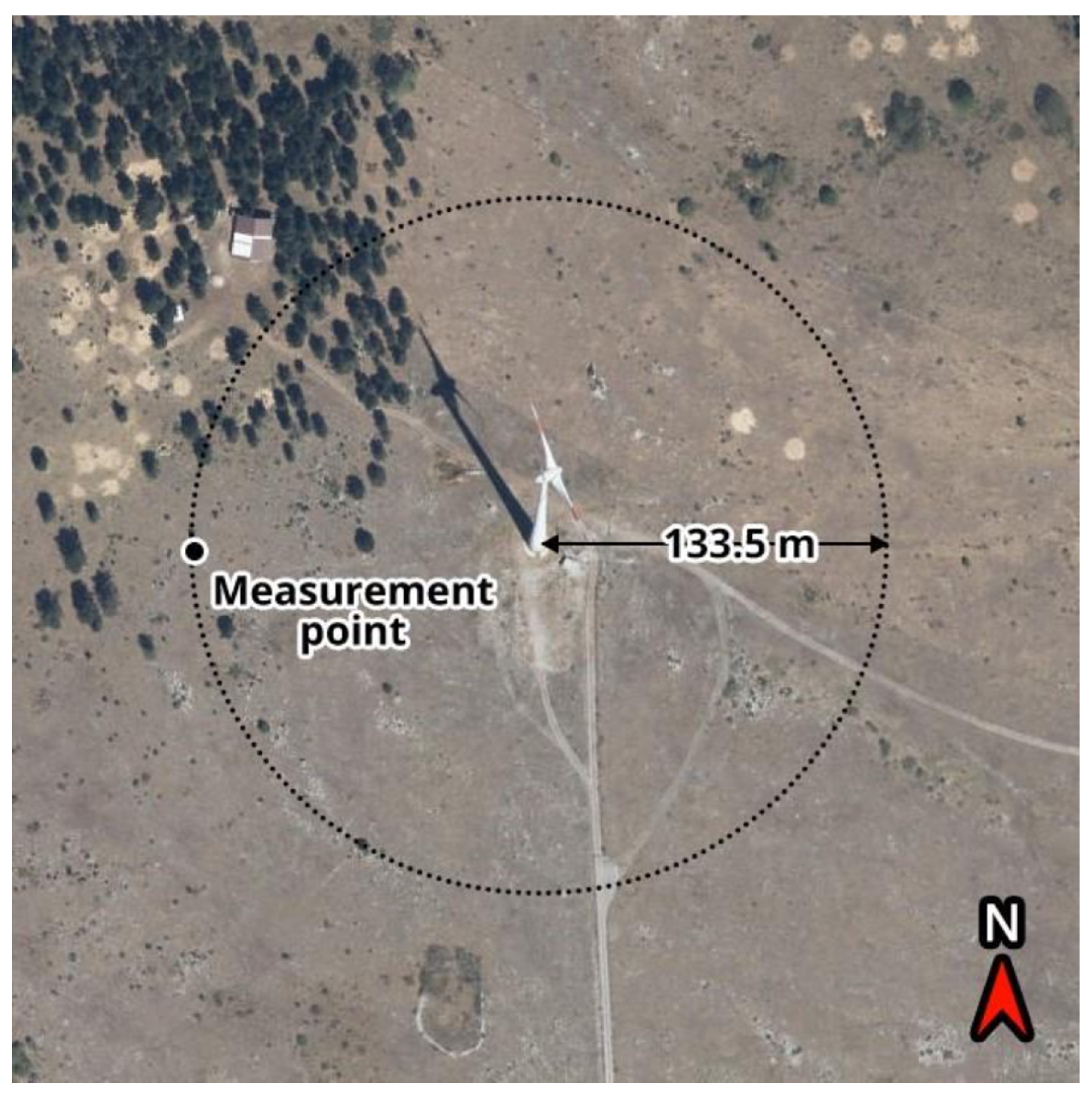

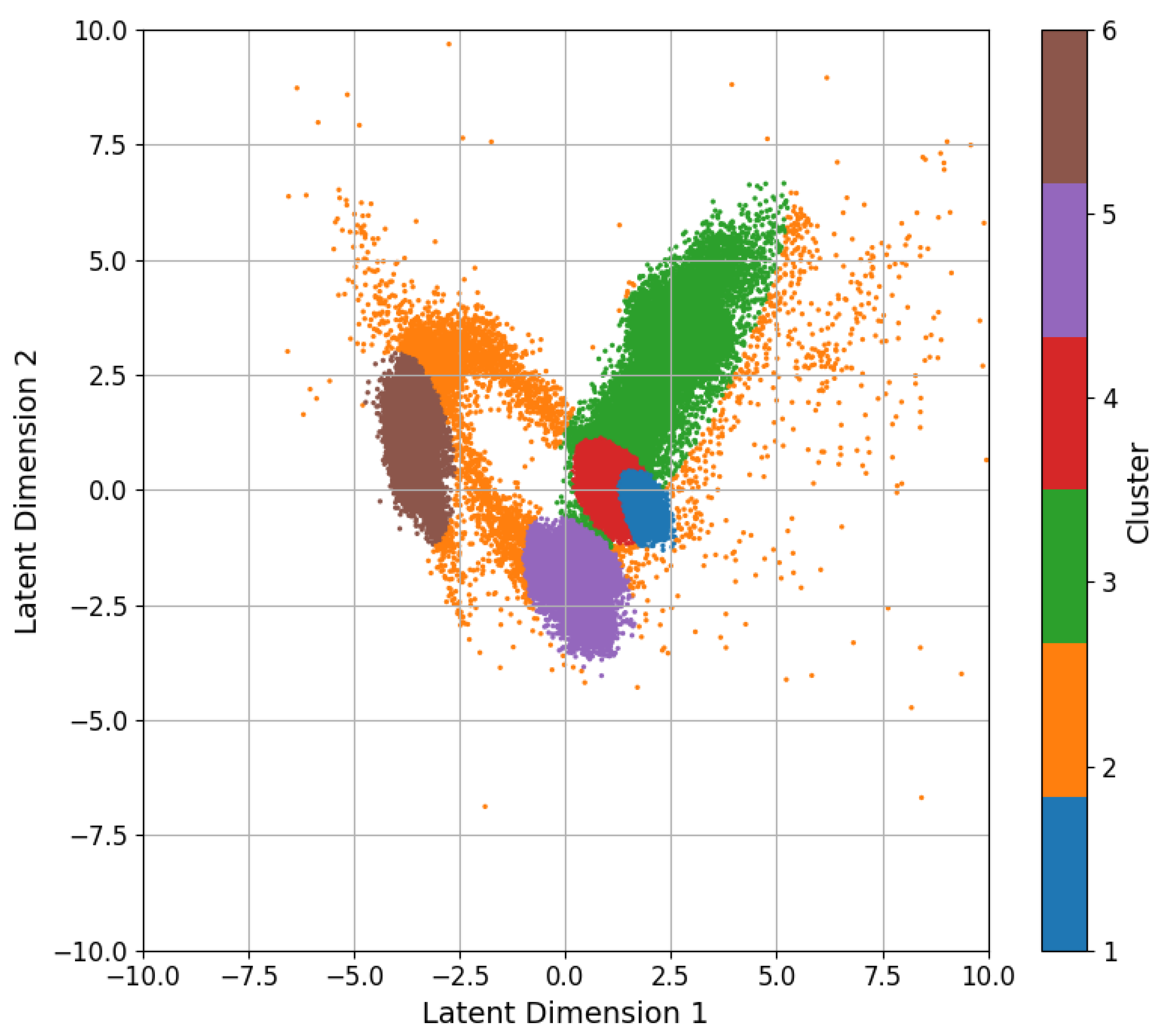
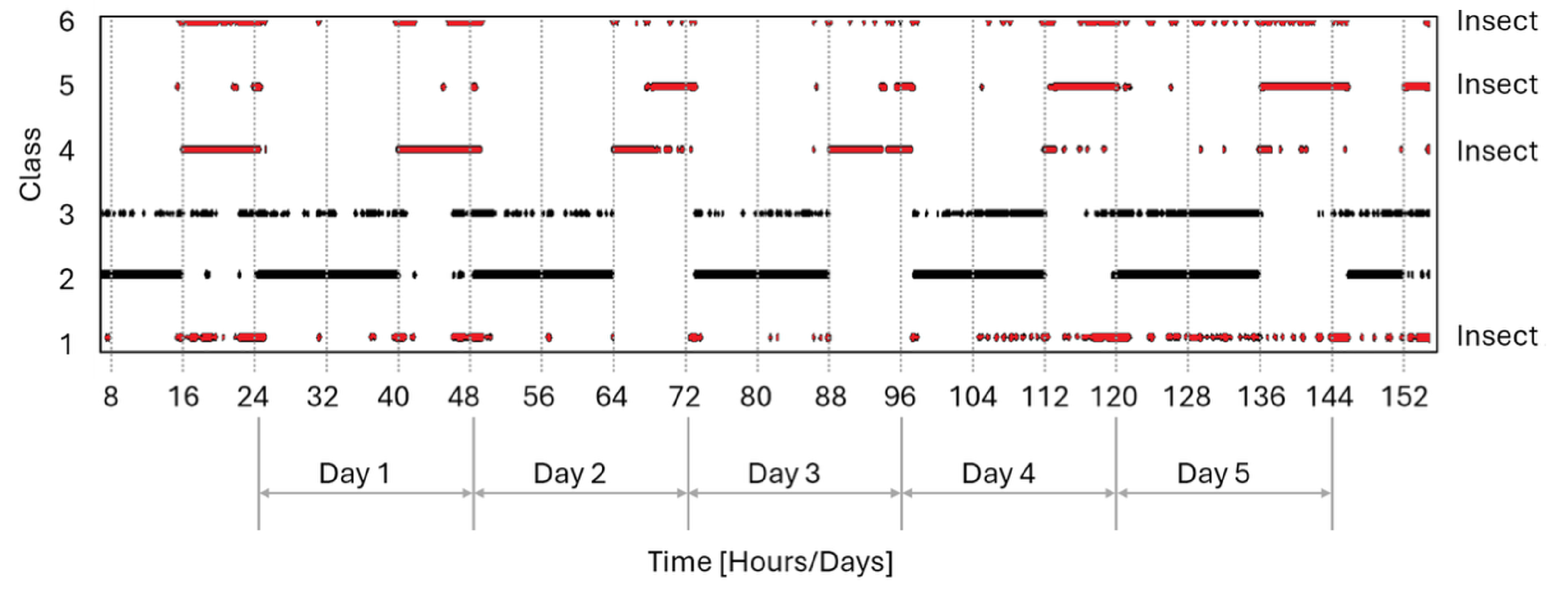
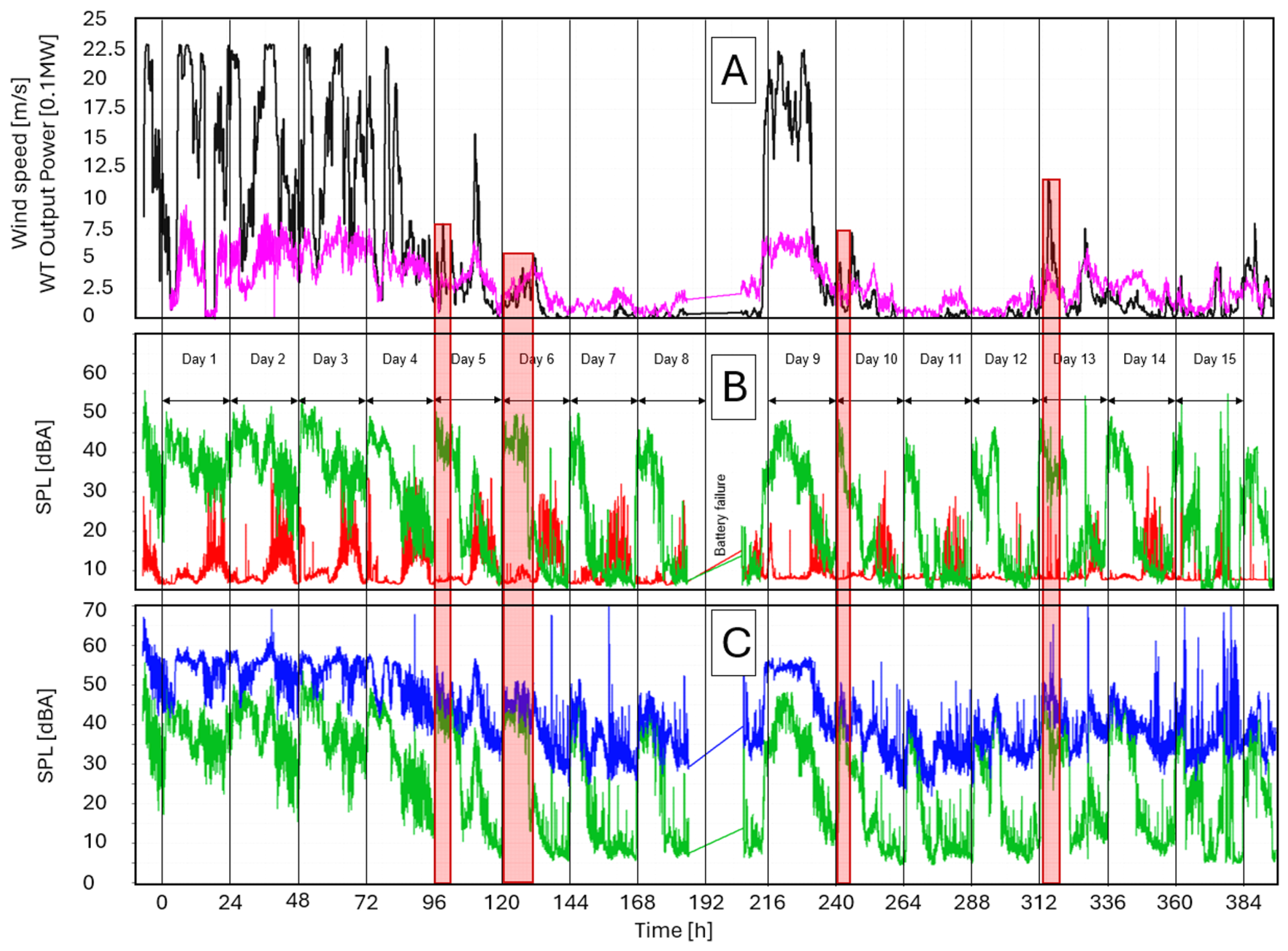

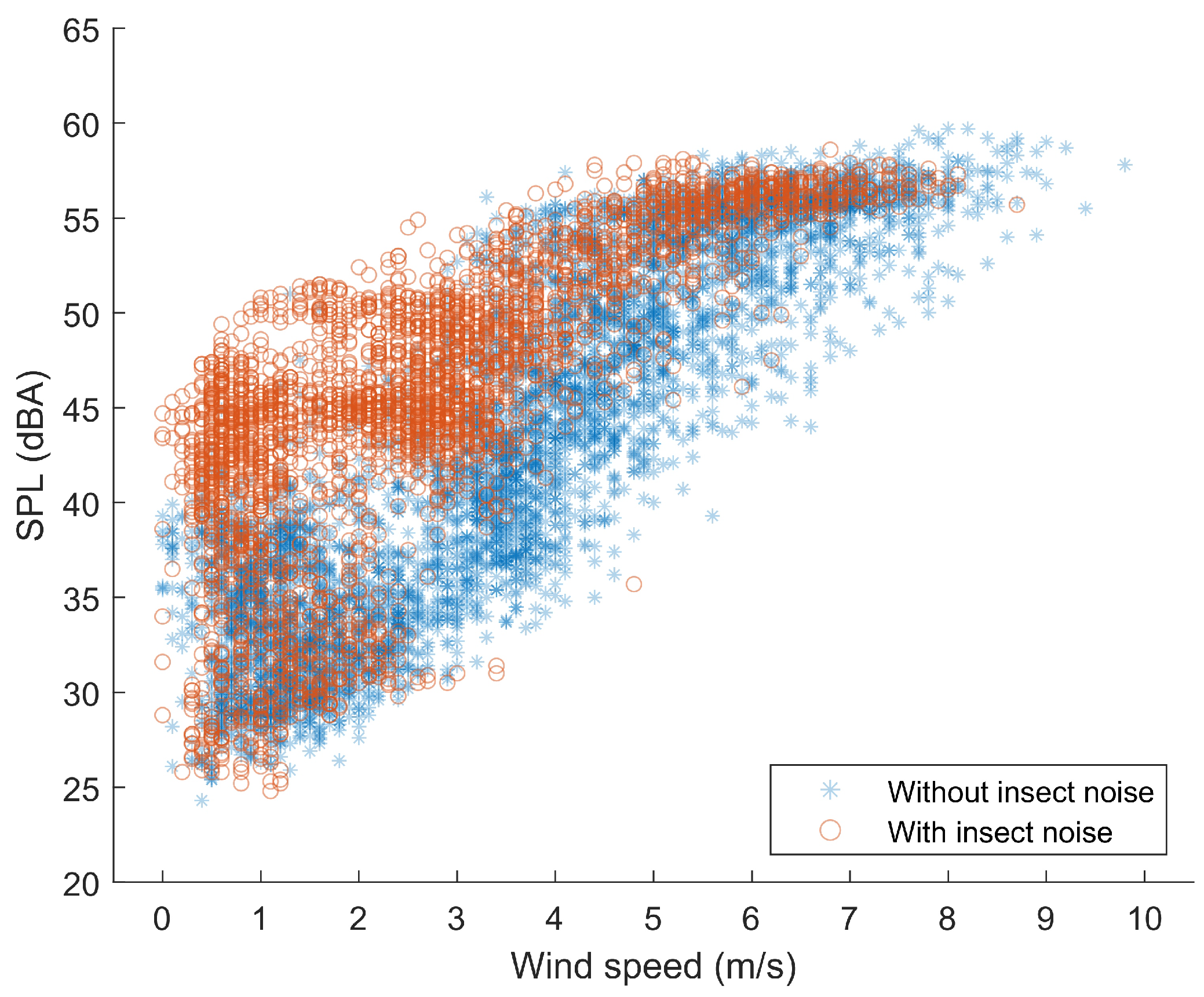
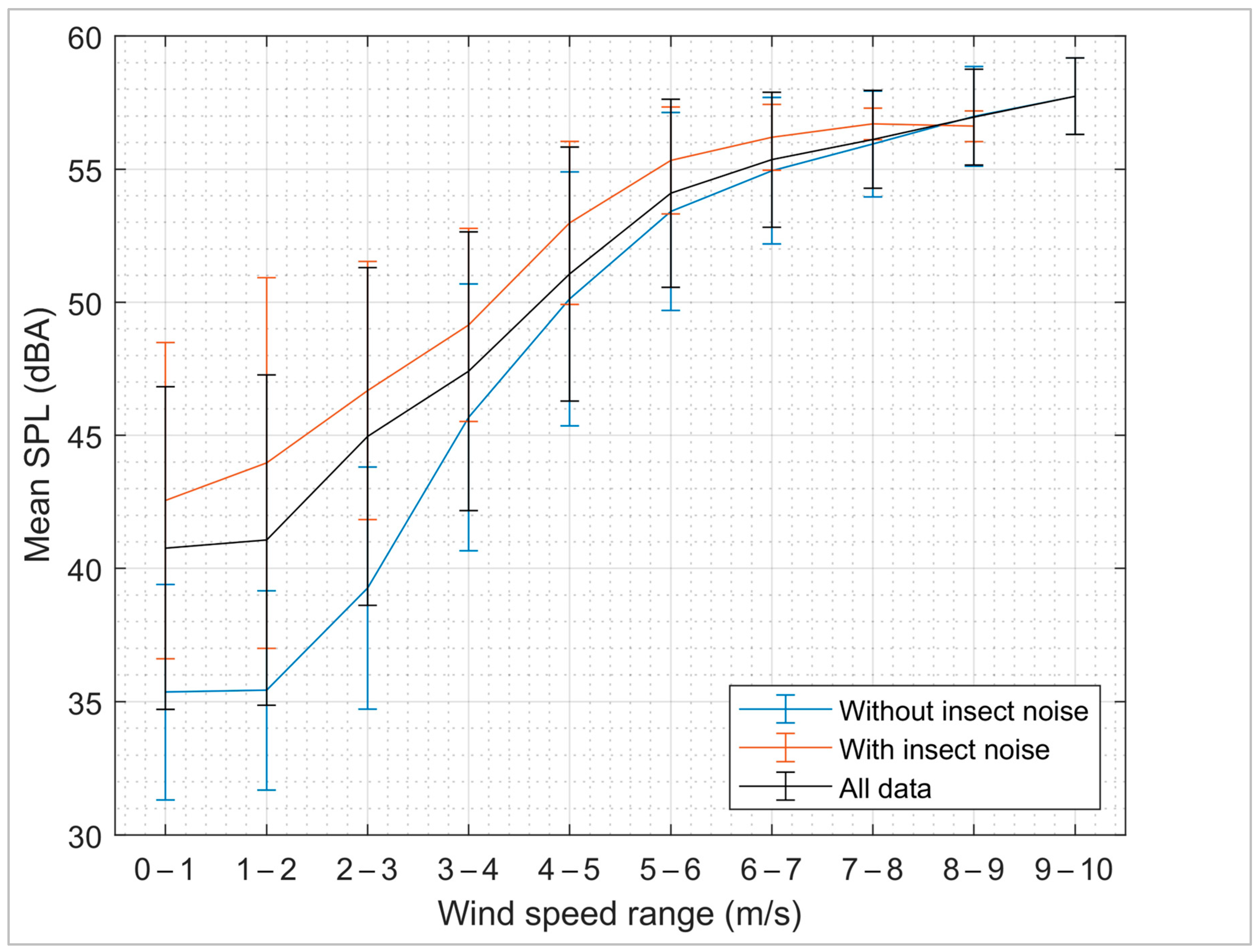
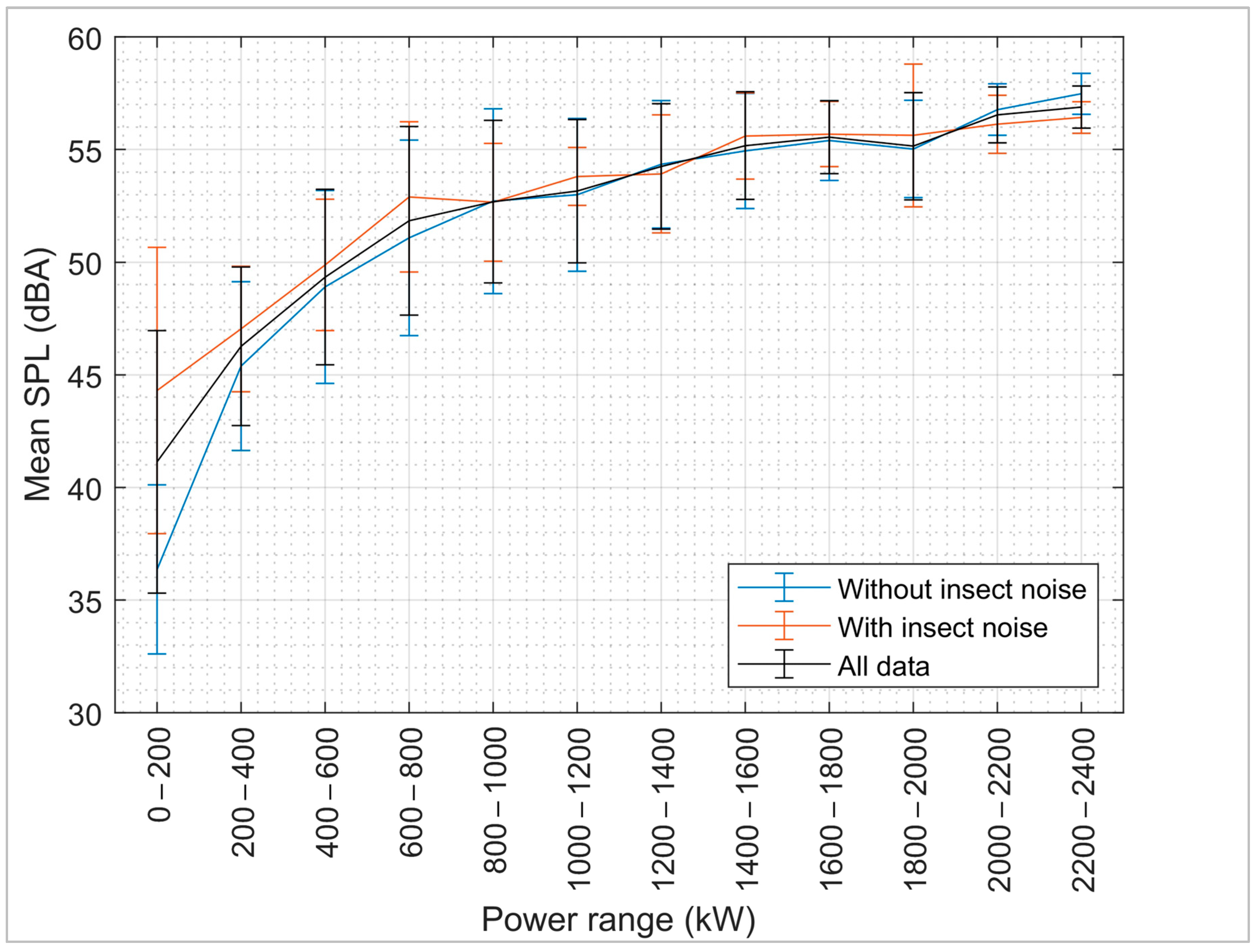
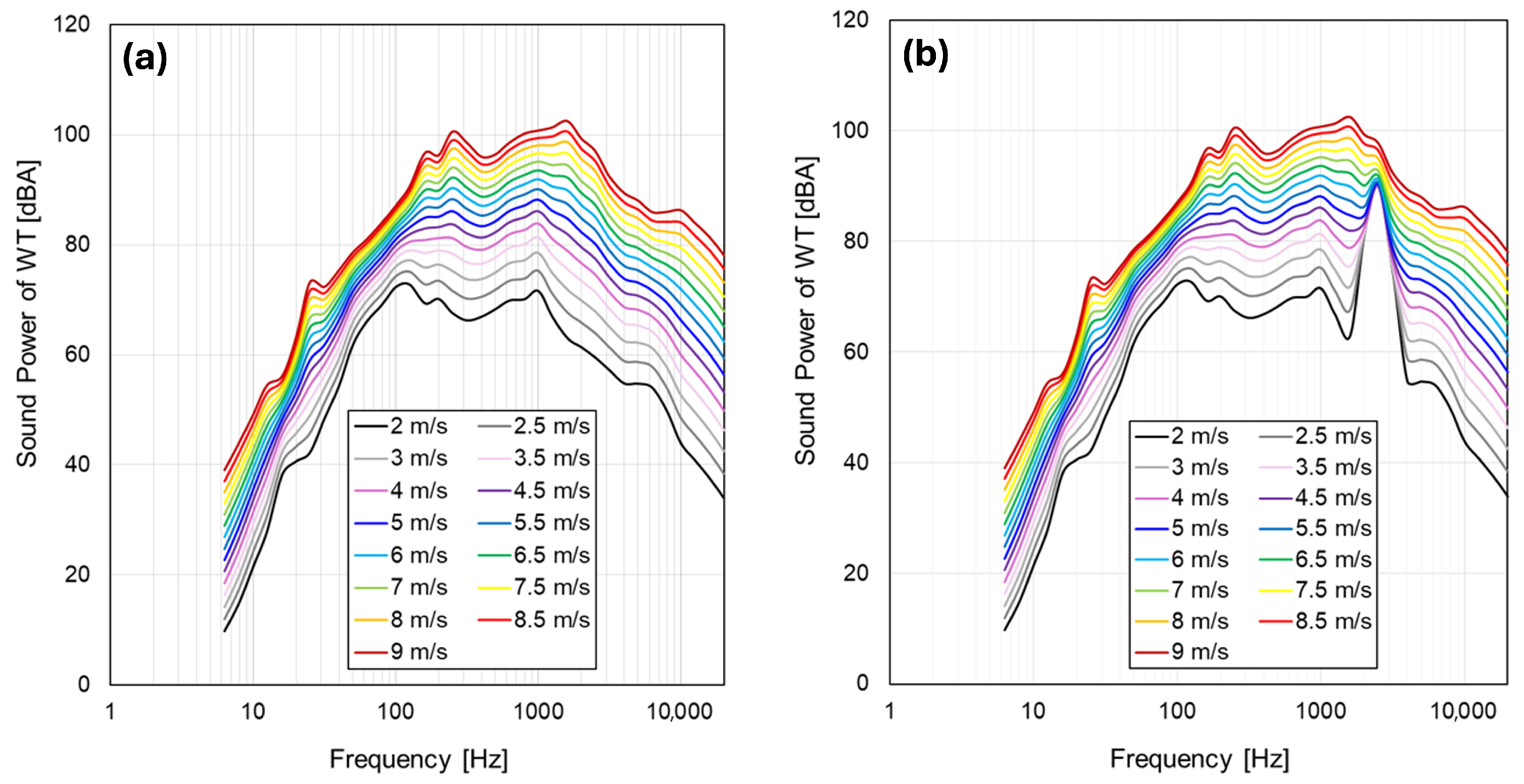

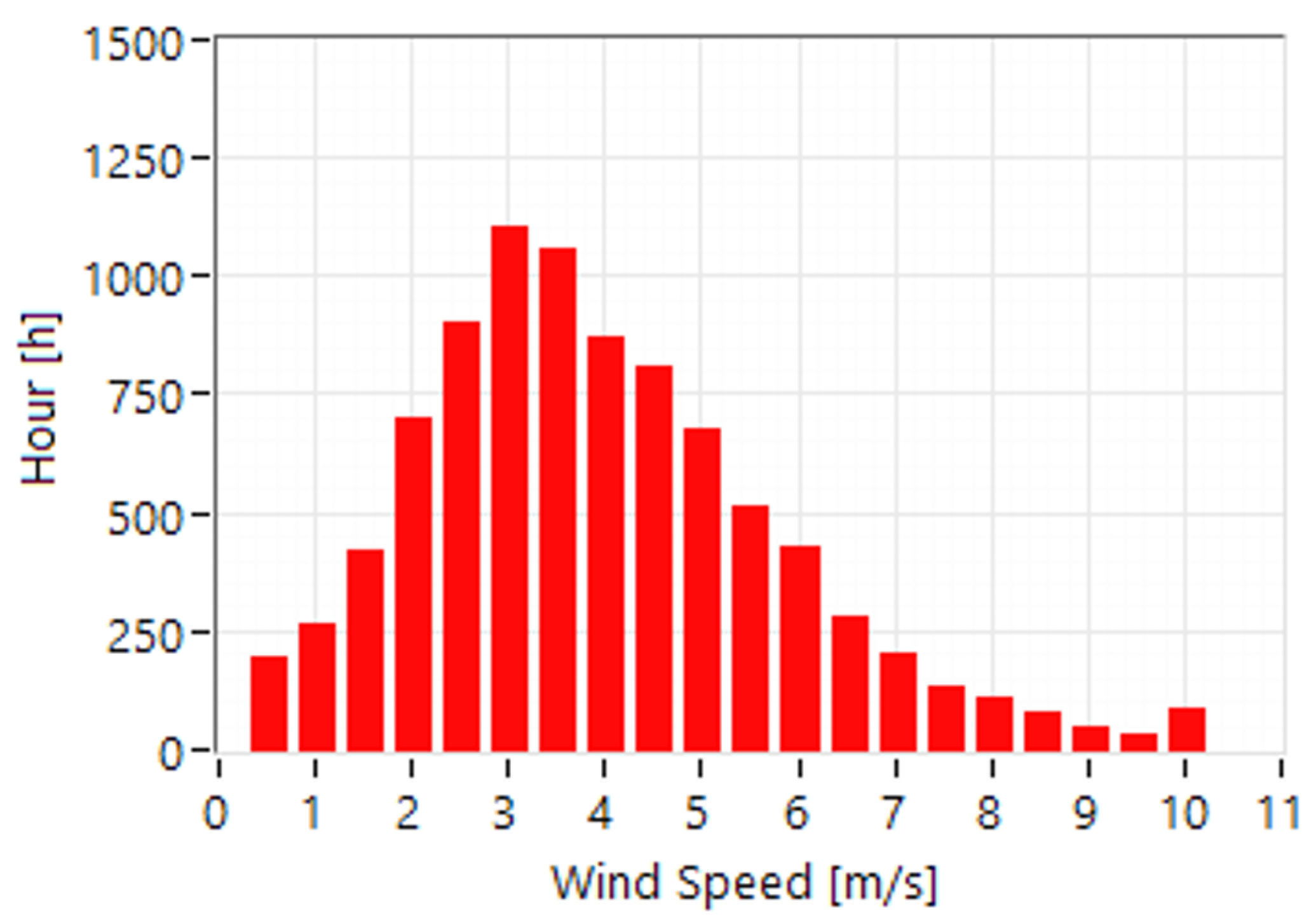
| Type of Ground | Roughness [Meters] |
|---|---|
| Water, snow, sand | 0.0001 |
| Open plain, bare soil, mown grass | 0.01 |
| Cultivated agricultural land | 0.05 |
| Residential area; small town, area with dense, tall vegetation | 0.3 |
| Distance [m] | 150 | 250 | 500 | 1000 |
|---|---|---|---|---|
| Lp with crickets | 43.3 | 37.6 | 32.6 | 25.1 |
| Lp with eliminated crickets [dBA] | 42.0 | 36.6 | 31.9 | 24.8 |
| Difference [dBA] | 1.3 | 1.0 | 0.7 | 0.3 |
Disclaimer/Publisher’s Note: The statements, opinions and data contained in all publications are solely those of the individual author(s) and contributor(s) and not of MDPI and/or the editor(s). MDPI and/or the editor(s) disclaim responsibility for any injury to people or property resulting from any ideas, methods, instructions or products referred to in the content. |
© 2025 by the authors. Licensee MDPI, Basel, Switzerland. This article is an open access article distributed under the terms and conditions of the Creative Commons Attribution (CC BY) license (https://creativecommons.org/licenses/by/4.0/).
Share and Cite
Prezelj, J.; Hvastja, A.; Murovec, J.; Čurović, L. Quantifying the Acoustic Bias of Insect Noise on Wind Turbine Sound Power Levels at Low Wind Speeds. Appl. Sci. 2025, 15, 11395. https://doi.org/10.3390/app152111395
Prezelj J, Hvastja A, Murovec J, Čurović L. Quantifying the Acoustic Bias of Insect Noise on Wind Turbine Sound Power Levels at Low Wind Speeds. Applied Sciences. 2025; 15(21):11395. https://doi.org/10.3390/app152111395
Chicago/Turabian StylePrezelj, Jurij, Andrej Hvastja, Jure Murovec, and Luka Čurović. 2025. "Quantifying the Acoustic Bias of Insect Noise on Wind Turbine Sound Power Levels at Low Wind Speeds" Applied Sciences 15, no. 21: 11395. https://doi.org/10.3390/app152111395
APA StylePrezelj, J., Hvastja, A., Murovec, J., & Čurović, L. (2025). Quantifying the Acoustic Bias of Insect Noise on Wind Turbine Sound Power Levels at Low Wind Speeds. Applied Sciences, 15(21), 11395. https://doi.org/10.3390/app152111395






